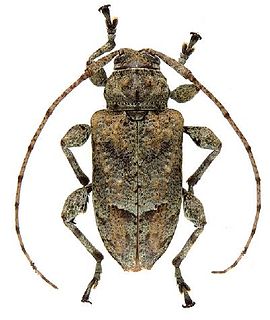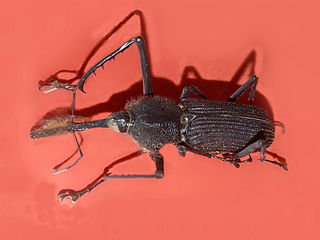
The New Zealand giraffe weevil, Lasiorhynchus barbicornis, is a distinctive straight-snouted weevil in the subfamily Brentinae, endemic to New Zealand. L. barbicornis is New Zealand's longest beetle, and shows extreme sexual dimorphism: males measure up to 90 mm, and females 50 mm, although there is an extreme range of body sizes in both sexes. In males the elongated snout can be nearly as long as the body. Male giraffe weevils use this long rostrum to battle over females, although small males can avoid conflict and 'sneak' in to mate with females, sometimes under the noses of large males. The larval weevils tunnel into wood for at least two years before emerging, and live for only a few weeks as adults.

Oiceoptoma noveboracense is a member of the family Silphidae, or carrion beetles, which feed on decaying organic matter such as dead animals. Its common name is the margined carrion beetle, from the orange-red margins on the pronotum, which are helpful when identifying this species. The larva is typically light brown to red and also has vertical ridges on its thorax like the adult. This diurnal beetle can be found mainly in the spring into the fall, and it has a strong preference towards a deciduous forest habitat. The primary forensic importance of this beetle is its ability to use the succession of insect fauna to provide confirmation of postmortem intervals.

Leptostylopsis annulipes is a species of longhorn beetles of the subfamily Lamiinae.
Brachypsectra fulva is a species of beetle in the Brachypsectridae family commonly known as the Texas beetle.

Cebrionini is a tribe of click beetles from the family Elateridae; formerly ranked as a subfamily or family, they are now considered a tribe within the subfamily Elaterinae.

Apoderus coryli, common name hazel-leaf roller weevil, is a species of leaf-rolling beetles belonging to the family Attelabidae subfamily Attelabinae. Because of the trunk-like elongated head, it is often mistakenly attributed to the weevils.

Rhinostomus barbirostris, common name Bottlebrush Weevil or Bearded Weevil, is a species of true weevil family.

Callosobruchus chinensis is a common species of beetle found in the bean weevil subfamily, and is known to be a pest to many stored legumes. Although it is commonly known as the adzuki bean weevil it is in fact not a true weevil, belonging instead to the leaf beetle family, Chrysomelidae. Other common names include the pulse beetle, Chinese bruchid and cowpea bruchid. This species has a very similar lifestyle and habitat to Callosobruchus maculatus and their identities are often mistaken for each other. This beetle is a common pest targeting many different species of stored legumes and it is distributed across the tropical and subtropical regions of the world. C. chinensis is one of the most damaging crop pests to the stored legume industry due to their generalized legume diets and wide distribution.

Bruchidius siliquastri is a species of bean weevil. It was first found in pods of Cercis siliquastrum in China, and has thence been found in several continents. Its length ranges from 2.8 to 3.7 millimetres. Its body is short and ovate, with a black integument. The apex of its femora and the ventral part of its hind tarsi are reddish. Its vestiture is made of thin and short setae; dorsally setae are a whitish colour, denser on the scutellum. Its pygidium is also covered with setae. Its name is derived from its host plant.

Cerambyx welensii is a species of beetle in the family Cerambycidae.

Cionus hortulanus is a species of weevils belonging to the family Curculionidae, subfamily Curculioninae.

Larinus turbinatus is a species of true weevil in the family of beetles known as Curculionidae.
Acronymolpus is a genus of leaf beetles in the subfamily Eumolpinae. It is endemic to New Caledonia. There are two species placed in the genus, both of which are sexually dimorphic; the females are large and reddish, and the males are small and black. A member of the tribe Eumolpini, Acronymolpus is distinguished from other members of the tribe in New Caledonia by its enlarged metacoxae, which occupy most of the first abdominal ventrite and nearly reach its posterior margin.

Sicoderus is a genus of true weevils in the beetle family Curculionidae. There are more than 75 described species in Sicoderus.

Lyperobius huttoni is a New Zealand weevil found in alpine areas of the South Island and at sea level around the Wellington coast. It feeds only on speargrass (Aciphylla). Weevils from the endangered Wellington population have been translocated to predator-free Mana Island.

Onthophagus dama, is a species of dung beetle found in Nepal, Bhutan, India, and Sri Lanka.
Myllocerus angulatipes, is a species of weevil found in India and Sri Lanka.
Hypoborus ficus, the fig bark beetle, is a species of weevil found in many European, Mediterranean and Asian countries.
Strattis srilankaiensis, is a species of weevil found in Sri Lanka.

Larinus sturnus is a species of cylindrical weevils belonging to the family Curculionidae, subfamily Lixinae.
















